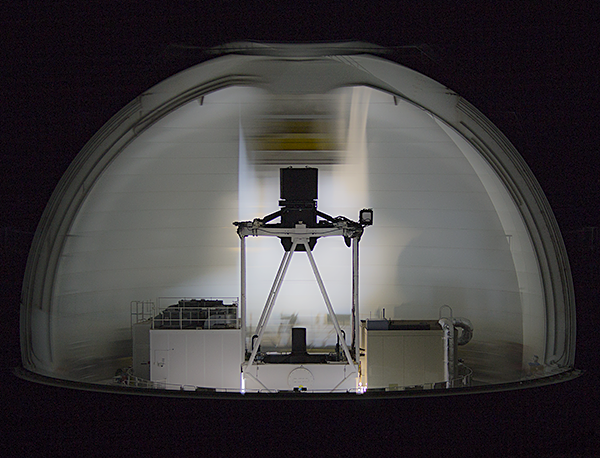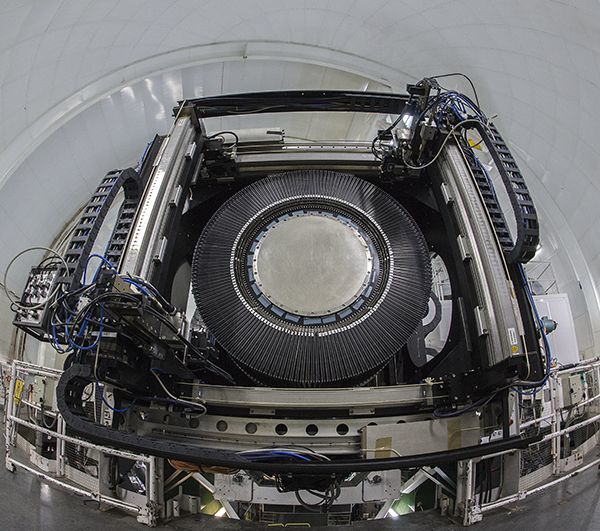ING press release
30 September, 2022
Start of LIFU-Mode Commissioning of WEAVE
Since our previous WEAVE news release in May, there has been a flood of
activity, to prepare, calibrate and test all of the WEAVE subsystems, now
working together for the first time.
After a few initial problems, the image quality in the focal plane is
now excellent, the spectrograph is well-focused and the other
subsystems are working well enough to begin commissioning the LIFU
mode of observations. LIFU commissioning has begun this week, and will
be followed by science verification of the LIFU mode, and then, once
the other sub-systems are ready, commissioning of the mIFU and MOS
modes.
We at ING are sure that you share our excitement to be so close to
generating real science data with this fantastic instrument, and we thank
the WEAVE community for their patience, enthusiasm and encouragement.
|

| The William Herschel Telescope with (in black) the new 6-lens corrector and WEAVE mounted at the top end. Photo taken on a pre-commissioning night. Credit: Javier Méndez and Lara Monteagudo. More.
|

| WEAVE at the top end of the WHT, with the telescope parked near-horizontal. One of the two plates for multi-object spectroscopy can be seen, surrounded by the fibre-retraction boxes. Above these is the gantry supporting the fibre-positioning robots. Credit: Javier Méndez. More.
|
About WEAVE
The ING initiated plans to build WEAVE after extensive consultation with the ING user community about what was needed for the future. There was a broad consensus that a world-class wide-field multi-object spectrograph was required to exploit from the ground the huge surveys being undertaken by powerful telescopes such as as ESA's Gaia, thereby helping to address the main astrophysical challenges foreseen for the next decade.
In 2016, the multi-lateral agreement to design and build WEAVE was signed by the countries of the ING partnership (the UK, Spain and the Netherlands), joined by France and Italy, with each country contributing major components as listed below, and with the ING providing auxiliary systems and overall project management.
The consortium is led by Gavin Dalton from the University of Oxford and RAL Space as Principal Investigator, Scott Trager from the University of Groningen as Project Scientist, Don Carlos Abrams from the ING as Project Manager, and Chris Benn from the ING as Instrument Scientist. The main components of WEAVE are:
- Fibre positioner, developed by the University of Oxford in the UK, with support from the Instituto de Astrofísica de Canarias (IAC) in Spain.
- Prime-focus system, designed by ING, IAC and SENER, provided by the IAC and manufactured by SENER. Support from Konkoly Observatory (HU). Lenses were polished by KiwiStar in New Zealand, funded by STFC, NOVA, INAF, IAC and ING, and mounted at SENER Aeroespacial (ES) by SENER and ING.
- Spectrograph, built by NOVA in the Netherlands with optical design by RAL Space in the UK, optics manufactured at INAOE (MX) and with support from INAF (IT) and the IAC.
- Field rotator, provided by IAC and manufactured by IDOM (ES).
Optical fibres, provided by the Observatoire de Paris in France, manufactured in France, Canada and USA.
- LIFU, built by NOVA (NL).
- CCD detector system, provided by Liverpool John Moores University in the UK.
- Data processing, analysis and archiving led by the University of Cambridge (UK), IAC (ES) and FGG-INAF (IT), respectively.
- Observatory control system, built by the ING.
WEAVE's construction has been funded by the Science and Technology Facilities Council (STFC, UK), the Netherlands Research School for Astronomy (NOVA, NL), the Dutch Research Council (NWO, NL), the Isaac Newton Group of Telescopes (ING, UK/NL/ES), the Instituto de AstrofÃsica de Canarias (IAC, ES), the Ministry of Economy and Competitiveness (MINECO, ES), the Ministry of Science and Innovation (MCI, ES), the European Regional Development Fund (ERDF), the National Institute for Astrophysics (INAF, IT), the French National Centre for Scientific Research (CNRS, FR), Paris Observatory – University of Paris Science and Letters (FR), Besançon Observatory (FR), Region Île de France (FR), Region Franche-Comté (FR), Instituto Nacional de Astrofísica, Óptica y Electrónica (INAOE, MX), National Council for Science and Technology (CONACYT, MX), Lund Observatory (SE), Uppsala University (SE), the Leibniz Institute for Astrophysics (AIP, DE), Max-Planck Institute for Astronomy (MPIA, DE), University of Pennsylvania (US), and Konkoly Observatory (HU).
More information:
About the Isaac Newton Group of Telescopes
The Isaac Newton Group of Telescopes is a unit of the Science and Technology Facilities Council (STFC) established on La Palma. It operates the William Herschel Telescope and the Isaac Newton Telescope with financial assistance from the Nederlandse Organisatie voor Wetenschappelijk Onderzoek (NWO) of the Netherlands, and the Instituto de AstrofÃsica de Canarias (IAC) in Spain.
|
|



